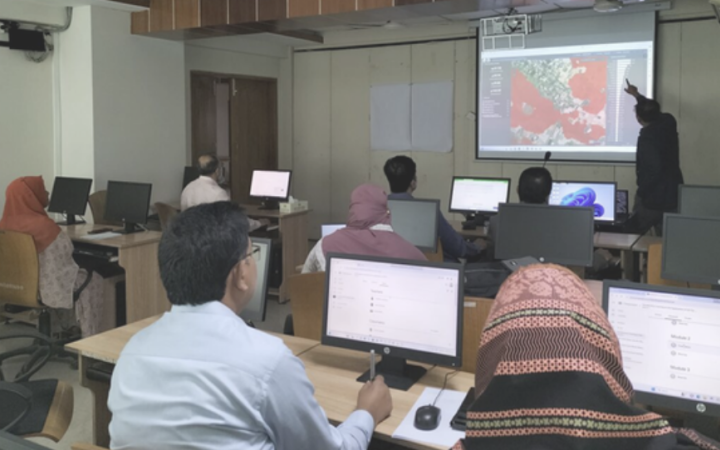23 February 2024, Dhaka, Bangladesh - In light of Bangladesh's susceptibility to a diverse range of disasters, encompassing floods, cyclones & storm surges, river bank erosion, earthquakes, droughts, salinity intrusion, fires, and tsunamis, strengthening its Geospatial Information System (GIS) capacities is imperative. This empowerment is crucial for enhancing the nation's resilience and preparedness in effectively responding to and managing these multifaceted challenges.
In a strategic initiative to bolster disaster resilience, the "Strengthening Capacities in the Use of Geospatial Information for Improved Resilience in Asia-Pacific and Africa" project, spanning 2021-2024, has successfully conducted a comprehensive training programme in Dhaka, Bangladesh, from 19 to 30 November 2023.
Supported by the Norwegian Agency for Development Cooperation (NORAD), UNOSAT's technological prowess has been leveraged to advance decision-making in Disaster Risk Reduction, Climate Resilience, Environmental Preservation, and Food Security.
In Bangladesh, the training, a pivotal component of the project, concentrated on foundational geospatial information technology (GIT) and its practical applications in disaster management. The overarching objective was to enhance the day-to-day performance of participants in utilizing QGIS software and basic GIT applications for effective disaster risk assessment.
A Journey Through Learning
The training unfolded over multiple modules, each addressing critical aspects of geospatial technology and disaster management. The journey began with Module 1, where participants mastered spatial data manipulation, visualization, and analysis within the QGIS interface, setting the stage for subsequent learning. Module 2 delved deeper into Earth observation and global datasets, refining participants' skills in change detection for land cover dynamics. In Module 3, participants acquired critical geoprocessing capabilities in QGIS for Population Exposure Analysis, offering valuable insights for decision-makers by estimating potential population exposure to tropical cyclones. Module 4 provided a hands-on experience in satellite remote sensing and GIS-based flood analysis, enabling participants to assess the aftermath of flooding events. Module 5 focused on practical applications, guiding participants in designing surveys and planning geospatial data collection projects for efficient disaster response operations. The final Module 6 elevated participants' skills in effective map design, emphasizing clear communication to convey crucial information for decision-making.
Results and Impact
The training's effectiveness was evident in the comprehensive assessment results. Participants overwhelmingly agreed on the acquisition of new information, the relevance of the content to their job, and the likelihood of applying the acquired knowledge. The methodology employed in the training received high praise, with participants expressing the usefulness of the overall programme.
Self-assessment activities revealed a remarkable increase in participants' confidence and competence. Before the training, only 1% considered themselves at a moderate to high level. After completion, a significant shift occurred, with 88.4% now viewing themselves at a moderate to high level. This underscores not only the impartation of knowledge but also the boost in self-esteem and proficiency.
“The GIS training session was most effective for a disaster management system, it was very interesting and interactive”, declared a participant at the end of the training. Participants unanimously lauded the trainers' effectiveness in presenting information, responding to questions, and stimulating participant involvement. Despite a gender distribution of 81.3% male and 18.8% female, both genders equally rated the training positively, emphasizing its inclusivity.
Decision-makers and technical staff in the Department of Disaster Management (DDM) were better equipped to recognize the advantages of space-based technology, understand the importance of geospatial data for disaster risk management, and appreciate the need for qualified trainers to enhance knowledge and skills.
In conclusion, the geospatial training programme in Bangladesh has not only equipped participants with essential skills for disaster resilience but has also contributed to building a community of practitioners. Recommendations from participants, including emphasis on hands-on exercises, integration of Python with GIS, and increased remote sensing-based GIS analysis, provide valuable insights for enhancing future training programmes.
As Bangladesh progresses in its disaster resilience endeavours, the success of this training programme becomes a beacon for future initiatives, showcasing the transformative impact of geospatial technologies on disaster management.


